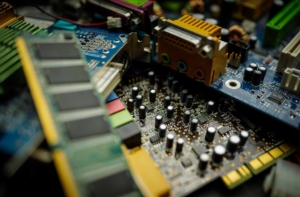The Many Paths of Waste: What Happens to eWaste After Disposal
It’s surprising to think about how many office items we consider disposable. From paper to pens, most of what we use in the office ends up in the trash, but that isn’t where the story ends.
For this blog, we will look at how the humble computer screen continues after its time in the office ends. Let’s explore the varied paths this item can take once it has served its purpose and how a company like CheckSammy can turn e-waste into a sustainability win, regardless of the industry.
Path 1: Landfill
One of the most common disposal methods is simply throwing the computer screen out with the trash. Once gathered, the screen goes to a landfill, where the screen can take years or decades to degrade. This approach wastes valuable resources and poses a significant ecological threat.
When left in a landfill, the lead, mercury, and other hazardous substances typically found in electronic items can leach into the ground, contaminating soil and groundwater. This can harm local ecosystems and potentially pose a risk to human health. You can read more about the far-reaching effects of such disposal and what you can do to play your part in mitigating risks in our most recent e-waste article.
Path 2: Incineration
Incineration is another common disposal method. While this may seem like a quick solution, it can also cause environmental problems. We know that electronic devices, including modern computer screens, contain multiple toxic substances, including brominated flame retardants and PVC plastics. When subjected to incineration, these materials transform, releasing harmful pollutants into the air, soil, and water.
The consequences extend to air pollution, with the incineration process emitting toxic substances such as dioxins and furans. These airborne pollutants pose a significant risk to both human health and wildlife, with potential long-term exposure leading to respiratory issues, developmental problems, and even an elevated risk of cancer.
The aftermath of e-waste incineration includes the production of ash containing concentrated levels of hazardous materials. If not managed appropriately, this ash can contaminate soil and water sources, permeating ecosystems and posing a direct threat to human health through the food chain.
Moreover, the incineration process may only guarantee the complete destruction of some hazardous materials within the e-waste. Incomplete combustion can produce new toxic by-products, compounding environmental and health concerns.
Beyond the immediate dangers, e-waste incineration contributes to the impact longer climate change issues. The release of greenhouse gases, including carbon dioxide, further contributes to the global environmental crisis. Which completely defeats the point of avoiding landfills.
Additionally, incinerating e-waste represents a missed opportunity for resource recovery through recycling. By opting for incineration over recycling, valuable materials are lost, perpetuating the demand for new raw materials and exacerbating resource depletion.
A shift towards sustainable e-waste management practices is imperative to address these multifaceted dangers. This process includes prioritizing recycling, proper disposal methods, and developing technologies that minimize the environmental and health impacts associated with the disposal of electronic waste.
Path 3: Recycling
Recycling is where companies like CheckSammy come into the picture. By responsibly recycling e-waste, we can dramatically lessen the environmental impact of discarded office computer screens.
It’s not enough to simply disassemble these screens. To be considered “recycled,” the individual components must be safely and responsibly processed. Recycled electronic waste undergoes a comprehensive series of processes aimed at extracting valuable materials while minimizing environmental harm. The journey begins with collecting discarded electronics from diverse sources, such as households, businesses, and manufacturers. These items are then meticulously sorted and segregated based on their type and the materials they contain.
The next crucial step involves the careful dismantling of electronic devices. Skilled workers, or automated processes, disassemble these electronics to extract individual components. This meticulous disassembly is pivotal for efficient recycling and material recovery.
Following dismantling, various materials are recovered from different components. Valuable metals like gold, silver, copper, and aluminum are extracted from circuit boards and wiring. Plastics from casings and covers, glass from monitors and screens, and precious metals from connectors are also reclaimed.
The recovered materials are often shredded or reduced to smaller sizes to enhance processing efficiency. Techniques such as magnetic separation, eddy current separation, and density-based separation are then employed to isolate and refine different materials. This process ensures a higher degree of purity in the recovered materials.
The final products of these recycling efforts are then used to manufacture new products, promoting resource conservation by reducing the demand for virgin raw materials. Functional components may also be refurbished for reuse, extending their lifecycle.
Throughout these processes, responsible e-waste recycling facilities adhere to environmental regulations and implement safeguards to prevent the release of hazardous substances into the environment. Any residual waste that cannot be recycled is disposed of properly, ensuring minimal environmental impact.
Some recycling facilities may seek certifications like e-Stewards and R2 (Responsible Recycling) to showcase their commitment to environmental standards and responsible recycling practices. These certifications set criteria for environmentally sound e-waste management.
In essence, the recycling of e-waste is a crucial component of sustainable resource management. It reduces the environmental impact of electronic waste disposal and contributes to the establishment of a circular economy by reintroducing recovered materials into the manufacturing process.
Path 4: Refurbishment and Reuse
Before jumping to recycle, one should consider one more path—refurbishment and reuse. In many cases, office computer screens still have plenty of life left in them. By refurbishing these items and putting them back into circulation, we can close the loop on e-waste, extending the life cycle of our electronic assets and reducing the demand for new products.
Even if your office screen is old or damaged, numerous parts from within it can be recovered and reused, such as circuit boards, precious metals, and plastics. Many companies throughout the world specialize in refurbishing e-waste, including computer screens. They meticulously clean, repair, and test these items before reselling them, offering an excellent alternative for environmentally conscious consumers.
Recycling with CheckSammy
CheckSammy’s e-waste recycling program is designed to meet the needs of businesses wishing to dispose of electronic waste responsibly. From small firms to multinational corporations, CheckSammy is equipped to handle e-waste of any scale.
CheckSammy ensures that each component of your office computer screen is recycled with the least environmental impact possible. Recycling can reclaim metals, plastics, and even glass and put these materials back into the manufacturing process, reducing the need for new raw materials.
Not only does working with CheckSammy mean that your old office computer screen is being disposed of responsibly, but you’re also actively contributing to a circular economy. It’s a win-win for all involved—businesses, consumers, and, most importantly, our planet.
The Importance of Corporate Responsibility
We all have a responsibility when it comes to the disposal of e-waste. However, companies can play a significant role in setting the standard. Corporate responsibility can make a massive impact by aligning with the UN’s Sustainable Development Goals.
To uphold this, many companies globally adopt an e-waste management policy that includes environmentally sound disposal methods and ethical recycling. These policies often include partnering with certified e-waste recycling and refurbishing companies like CheckSammy.
By becoming a CheckSammy corporate partner, businesses can integrate these best practices seamlessly into their operations. Combined with CheckSammy’s analytic program, Veridiant, companies can easily demonstrate their commitment to the environment and provide companies with credibility and a reputable brand image in the consumer marketplace.
The Future of E-Waste and the Role of Innovation
As technology advances and we produce more e-waste, new disposal and recycling methods are being researched. For example, some scientists are investigating the use of hydrometallurgical processes to recover precious metals from e-waste efficiently.
CheckSammy is at the forefront of integrating these innovative approaches into their operations when proven safe and effective. By consistently evolving our processes, we can remain a frontrunner in sustainable e-waste management and continue contributing to a circular economy.
Parting Thoughts
As the pace of technological advances continues to accelerate, we must think about the lifecycle of each device we use, especially the office computer screen. Knowing how and where to recycle these items responsibly is a significant step in the right direction, and businesses like CheckSammy are leading the way in these sustainability efforts.
In conclusion, recognizing the many paths of waste that office computer screens take after disposal is the first step towards implementing responsible e-waste management. By choosing the path of refurbishment, recycling, and responsible disposal, we preserve our environment and pave the way for a sustainable future. For effective waste management solutions that champion a circular economy, contact CheckSammy today.
See Our Services
Create a custom solution to meet your waste and sustainability goals. Contact us today!
Continue reading
Dive deeper into the CheckSammy Blog by reading one of our posts below
Feeling the Pain of Higher Resident Turnover? Apartment Junk Removal Can Help
If you’re a property manager, you’ve probably had a significant increase in tenant turnover over the last couple of years. So it’s no wonder apartment junk removal may be top of mind for you right now. There are several reasons for this shift. For one, the housing market is on fire right now. In 2020 […]
Read More About Feeling the Pain of Higher Resident Turnover? Apartment Junk Removal Can HelpSetting Up a Community E-waste Recycling Program
E-waste is the fastest-growing municipal waste stream according to the EPA, yet e-waste recycling isn’t keeping pace. In fact, only 12.5% of all e-waste is recycled, reports the EPA. Starting a community e-waste recycling program is a terrific way to ensure hazardous e-waste, like lithium-ion batteries, doesn’t end up in your community’s landfill. Creating an […]
Read More About Setting Up a Community E-waste Recycling ProgramWaste Management’s Role in the Circular Economy
Establishing a waste management program for your business or community is one of the best ways you can contribute to the circular economy. Here’s everything you need to know about waste management’s role in the circular economy (and how to get involved). What Is the Circular Economy? Our current economic model is all about taking […]
Read More About Waste Management’s Role in the Circular Economy5 Reasons to Consider a Textile Recycling Program for Your Organization
Americans sent more than 17 million tons of textiles to landfills in 2018, a volume that is only increasing every year, reports the Environmental Protection Agency. When you think about the fact that it can take over 200 years for textiles to decompose, it’s easy to grasp how large textile waste’s contribution is to the […]
Read More About 5 Reasons to Consider a Textile Recycling Program for Your Organization8 Benefits of Environmentally Friendly Power Washing Services
If you’re into maintaining the curb appeal of your business or home, then you’ve probably heard of pressure washing. Pressure cleaning involves using high-pressure water spray to remove grime, mold, dust, paint, mud, and other junk from objects or surfaces. Many people worry that pressure washing isn’t good for the environment, but this couldn’t be […]
Read More About 8 Benefits of Environmentally Friendly Power Washing ServicesWhy Our Customers Love Our Full-Service Junk Removal
If you’re looking for full-service junk removal services, you’ve come to the right place. CheckSammy is a one-stop shop for all your junk removal and sustainability needs. From our affordability, simplicity, and unrivaled turnaround times to our innovative sustainability solutions and patented technology and data, it’s clear why some of North America’s biggest companies choose […]
Read More About Why Our Customers Love Our Full-Service Junk RemovalTips for a Stress-Free Move From An Eco-Friendly Junk Removal Company
What does an eco-friendly junk removal company know about moving? Quite a lot, actually. Moving can be an especially chaotic time. You have to pack everything up, get rid of unwanted items, clean your property, load everything up, and move your things to your new location. That doesn’t even include the unpacking and resettling period. […]
Read More About Tips for a Stress-Free Move From An Eco-Friendly Junk Removal CompanyCollege Junk Removal Tips for Student Move-In Day
As the new school year gears up, colleges across the country are looking for ways to clean up their campuses before the new year begins, and many of them want to do so sustainably. College junk removal isn’t easy, though, especially around move-in week—and when trying to do so sustainably. As students move in and […]
Read More About College Junk Removal Tips for Student Move-In Day8 Items Hospitality Businesses May Not Know They Can Recycle
One hotel guest produces 2.5 pounds of trash every single day. Just a single hotel room produces around one cubic yard of waste each month, which totals 200 gallons of waste per room every month. Most of this waste goes straight to the landfill, even though research shows that up to 60% of it is […]
Read More About 8 Items Hospitality Businesses May Not Know They Can Recycle












